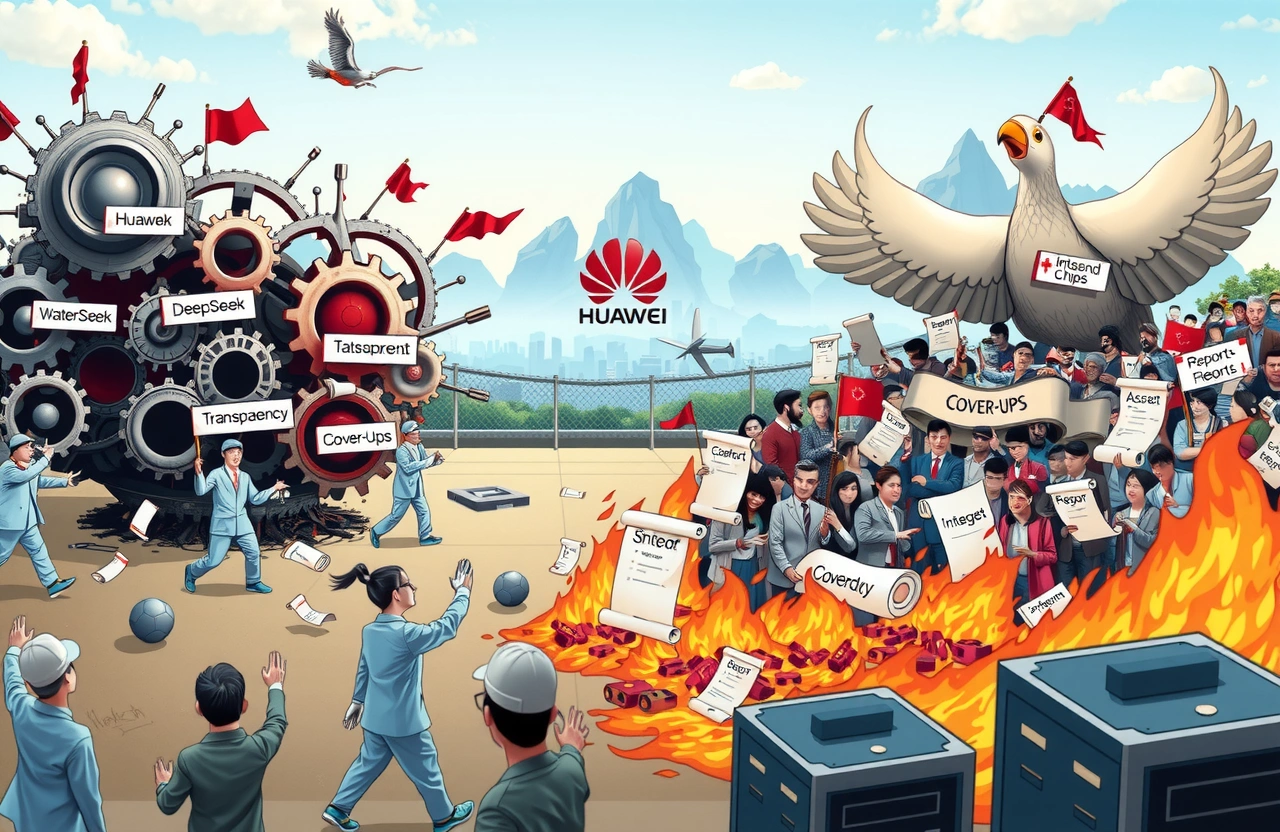Behind Huawei’s Proud AI Facade
A Huawei Noah’s Ark Lab employee bravely risks career termination to expose disturbing malpractice within Huawei’s flagship Pangu artificial intelligence project. This firsthand testimony details systematic deception including: Shelling competitor models as Huawei originals; Continued-training shortcuts covering technical weaknesses; Watermark-washing techniques masking intellectual theft. The Huawei Pangu AI scandal reveals dangerous compromises beneath China’s AI ambitions.
The Huawei Pangu AI scandal strikes at the heart of China’s technological integrity. This whistleblower account exposes how Huawei’s race against competitors like Alibaba and DeepSeek triggered unethical compromises undermining China’s much-promoted AI independence narrative.
Key revelations include:
- Calculated plagiarism of Alibaba’s Qwen and DeepSeek models
- Systematic rewrites of technical reports concealing origins
- Leadership pressure silencing ethical objections
- Toxic workplace culture causing mass talent exodus
Whistleblower Credentials Unveiled
The Huawei employee provides damning inside access:
Organizational Structure Exposed
Detailing Noah’s Ark Lab’s structure – including MSS Small Model Lab leader Wang Yunhe (王云鹤), former director Yao Jun (姚骏), and executives Tang Ruiming, Shang Lifeng, and Zhang Wei. The “Fourth Field” division system reveals tight compartmentalization with separate columns handling fundamental language models.
Suzhou Siege Pressure Cooker
Workers endured mandatory Saturday work sessions in isolated Suzhou facilities, some separated from families for months. Despite occasional perks like lobster dinners, psychological tolls mounted from constant deadlines, hotel confinement, and frequent workspace relocations.
Technical Shortcuts Formation
Decisions seeding ethical compromises:
Tokenizer Troubles
Early Pangu versions wasted computation power through inefficient tokenizers where every character/space required separate processing. When Huawei switched tokenizers mid-training using MSS Lab vocabulary, failures plagued Qwen competitors.
Shelling Emergence
Facing catastrophic results from a failed 230B dense model, Wang Yunhe’s team performed their first “shelling”: Taking Alibaba’s Qwen 1.5-110B architecture, adding token layers and tweaking dimensions to simulate Huawei’s planned 135B parameter structure.
Demoralizing Dishonesty
Internal analysis showed suspicious parameter alignment with Qwen – even preserving class names in model code. The Huawei Pangu AI scandal birthed mocking internal nicknames like “Qian-Gu” (千古老 “Ancient Qwen”). Multiple senior staff attempted BCG ethics complaints blocked by management.
Watermark Washing Process
Later cloning operations used sophisticated contamination techniques:
- Deliberate training with corrupted/noisy data
- Embedding pattern randomization techniques
- Vector space obscuring detectable signatures
These techniques become standard practices throughout subsequent shelling operations.
Shelling Methodology Evolution
The whistleblower chronicles incidents:
Qwen Shelling Operation
The seminal plagiarism case saw externally supplied clients receiving models directly built from Alibaba’s architecture. Whistleblowers confirm:
- Original Qwen 107 layers vs cloned 82-layer Huawei version
- Near-identical parameter distributions
- Undisclosed training continuation origins
DeepSeek V3 Cloning
In early 2025, MSS Lab froze DeepSeekv3’s parameters while retraining extensions – preserving checkpoint directories named “deepseekv3”. Meanwhile, ethical engineers struggled on paralleled native model development facing withheld resources.
Talent Exodus Acceleration
The Huawei Pangu AI scandal triggered hemorrhaging:
Ethical compromises drove star researchers to ByteDance Seed, DeepSeek, Moonshot AI, Tencent, and Kuaishou. Departing engineers termed Huawei tenure “career shame” while resignation posts avoided exposing colleagues still trapped amid retaliation fears.
An insider admits:“We’re using Communist Party’s guerilla tactics – but with Nationalist Party bureaucracy.” Weighted against competitors using NVIDIA hardware, Huawei’s struggles compound through morale collapse.
Corporate Accountability Failure
Leadership Covering Creation
The whistleblower identifies:
- Wang Yunhe (王云鹤) personally directing shelling initiatives
- Senior leadership including Yao Jun (姚骏) knowingly permitting breaches
- Routine resource diversion to unethical projects
Escape clauses bypassing Huawei’s strict model provenance tracking were granted exclusively to MSS Lab engineers.
Crisis Management Strategy
Following HonestAGI revelations, Huawei mobilized damage control:
- Internal “analysis workshops” crafting rebuttals
- Technical report authors pressured for unified response
- Information lockdowns suppressing dissent
Echoes Across China’s AI Industry
The Huawei Pangu AI scandal threatens broader consequences:
Technology Sovereignty Paradox
China’s national computing hardware pride (Ascend chips) struggles offsetting reliance on borrowed architectures. This plagiarism permanently clouds legitimate Huawei achievements like stable training on homegrown silicon.
International Implications
Exporting cloned models exposes Huawei (growing globally) to intellectual property lawsuits. Detection methods evolve through flashpoints like HonestAGI’s forensic breakthroughs.
Ethical Development Movement
Transparency coalitions like Coordinate AI gain traction advocating standards preventing such incidents.
The Path Beyond Scandal
This whistleblower account ends confirming Huawei retains technical brilliance – needing only to fix toxic culture preventing ethical deployment.
Integration Actions Required:
- External ethics audits of flagship AI projects
- Career protections preventing suppression paralysis
- Technical report historical correction initiatives
The Huawei Pangu AI scandal must become the moment condemning counterfeit AI creation globally. Support transparency reforms demanding:
- Watermarking standards for model authorship
- Bug bounty programs detecting cloned systems
- Public dataset lineage tracking protocols
Spread technical integrity standards by sharing documented incidents forcing substantive industry change.




